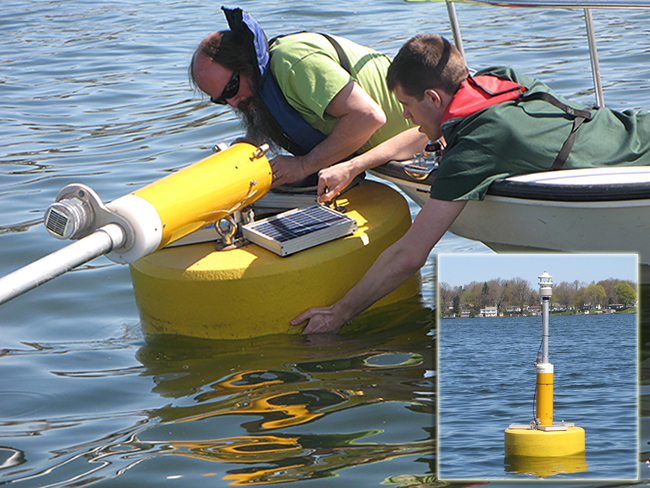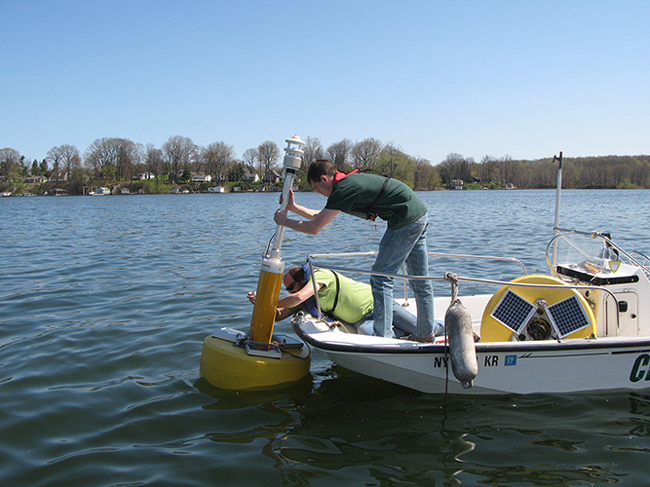Buoys, installed through funding by NYSG and partners, help predict toxic algal blooms

Michael Satchewell and Matt Blake Deploy Bouys in Sodus Bay
Syracuse, NY, July 6, 2016 - A crisp, clear spring morning when sunlight sparkles off the water might seem like an odd time to think about toxic algal blooms that coat the water in a thick blue-green film, but it's precisely when researchers start water monitoring.
Toxic blue-green algal blooms in the northeastern United States typically form during the hot days of August. By keeping an eye on the water chemistry throughout the summer, researchers might be able to predict when a potential bloom is coming.
Michael Satchwell, senior research support specialist at ESF, and undergraduate Matt Blake deployed three buoys in Sodus Bay in early May to monitor water conditions in the bay. The solar-powered buoys measure the basic water chemistry, including temperature, pH, conductivity and dissolved oxygen levels, chlorophyll and phycocyanin, a pigment specific to blue-green algae. The central buoy houses a complete weather station and also records water levels. This data is being used to produce models of water movement within the bay.
"If we see a spike in phycocyanin levels we know a potential bloom may be coming," said Satchwell. Data from the buoys is transmitted in near-real time to the Great Lakes Research Consortium's Web site where anyone can access the data. It is also being used by researchers at the University of Buffalo to build a better predictive model for the occurrence of harmful algal blooms.
"If we get them (blue-green algal blooms), we get them typically in the late summer," said Ed Leroux, a resident of Sodus Bay who assists the ESF team.

The bay experienced a major bloom in 2010 that shut down businesses two weeks before Labor Day, delivering a blow to the popular tourist area. "No one was in the water, no one was in the restaurants," Leroux said. "It woke the community up. We had to find out why it happened and how it happened because it had a serious economic impact on the community."
Blue-green algae blooms, or cyanobacteria, can be harmful to humans and fatal to pets. Exposure to the algae can result in diarrhea, nausea or vomiting; skin, eye or throat irritation; and allergic reactions or breathing difficulties.
Save Our Sodus, a group dedicated to addressing challenges to the quality of Sodus Bay, asked Dr. Greg Boyer of the ESF Department of Chemistry to look into the matter. Boyer, director of the Great Lakes Research Consortium and member of Save Our Sodus, has studied algal blooms in numerous water bodies in the Northeast and China for more than three decades.
Boyer began random water sampling in the bay in 2011 and has been collecting data, sometimes on a weekly basis every since. This information forms the basis of a weekly report that appears on the Save our Sodus website to inform the general public about conditions on the bay. The buoys were installed in 2011 to automate the process with funding from a number of sources, including a grant with the U.S. Environmental Protection Agency through the Great Lakes Restoration Initiative, New York Sea Grant and funding from the Great Lakes Observing System.
"To date, data shows chlorophyll has dropped off while phosphorus levels vary up and down, and toxicity is down; but that doesn't necessarily mean things are getting better. Phosphorus levels have to be in check and we have to be able to predict the toxicity levels," said Boyer.
Blooms are known to form in tight corners and areas with little water circulation, such as marinas, so the town installed blowers - normally used to keep ice from forming - to help keep the water moving in the summer, Leroux said.
So far, researchers have not identified a "smoking gun" that identifies what precisely triggers the toxic blooms. However work with the University of Buffalo strongly suggests that water movement in and out of the bay may be an important contributor.
Fortunately for the merchants and tourists in Sodus Bay, algal blooms have not been troublesome over the last few years. "There hasn't been a significant bloom since 2010," noted Satchwell.
"If you keep studying it, it won't come back," Leroux said, somewhat tongue in cheek. "So we're going to study it to death."
More Info: New York Sea Grant
New York Sea Grant (NYSG), a cooperative program of Cornell University
and the State University of New York, is one of 33 university-based
programs under the National Sea Grant College Program (NSGCP) of the
National Oceanic and Atmospheric Administration (NOAA). The NSGCP
engages this network of the nation’s top universities in conducting
scientific research, education, training and extension projects designed
to foster science-based decisions about the use and conservation of our
aquatic resources. Through its statewide network of integrated
services, NYSG has been promoting coastal vitality, environmental
sustainability, and citizen awareness about the State’s marine and Great
Lakes resources since 1971.
New York Sea Grant maintains Great Lakes offices at SUNY Buffalo, the
Wayne County Cooperative Extension office in Newark and at SUNY Oswego.
In the State's marine waters, NYSG has offices at Stony Brook University
and Stony Brook Manhattan, in the Hudson Valley through Cooperative
Extension in Kingston and at Brooklyn College.
For updates on Sea Grant activities: www.nyseagrant.org has RSS, Facebook, Twitter, and YouTube links. NYSG also offers a free e-list sign up via www.nyseagrant.org/coastlines for its flagship publication, NY Coastlines/Currents, which is published several times a year.